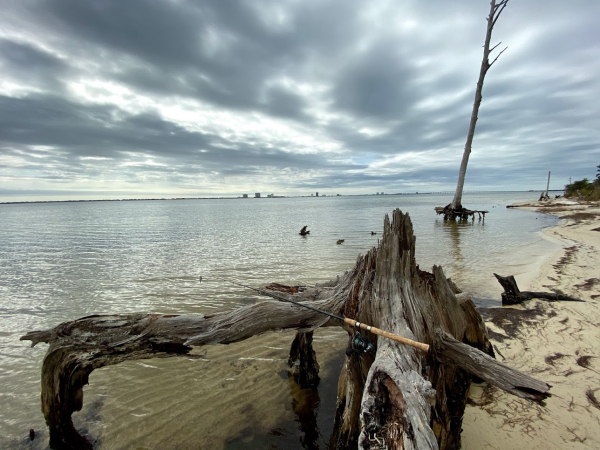
Beaching It Fishing at Pensacola |
| By Frank Sargeant from The Fishing Wire It sometimes seems that half of the population from North Alabama all the way to the Canadian border heads for the Gulf beaches on winter holidays. There’s good reason. Not only is the climate significantly more pleasant, but the emerald green waters and white sand beaches extend for endless miles. Beaches here are regularly adjudged to be among the best not only in the U.S. but worldwide. And for anglers, the change from a steady regimen of catch-and-release bass—or of punching holes through ice for walleyes and perch– gets “salted” with seatrout, redfish, flounder, sheepshead and many other species—all of them as tasty on the table as they are exciting on the line. While Panama City Beach, Miramar and Destin are well-known favorites for many families, there are other attractive locations where the beach is just as good or better, and where the crowds are far sparser for much of the season. One of my personal favorites is the shore between Navarre Beach and Pensacola Beach plus the Gulf Islands National Seashore (GINS)beyond, extending all the way to Pensacola Pass. Much of this area is completely undeveloped, not only on the beach but also on the backwater lagoons, thanks to the vast sprawl of Gulf Islands National Seashore, which begins here on Santa Rosa Island and leapfrogs all the way to the waters of Ship Island, Mississippi—some 135,000 acres total, stretching over 160 miles along the northern edge of the Gulf. There are small communities on Santa Rosa, both on the Navarre Beach and the Pensacola Beach end with hotels, restaurants and shops, but for the most part much of the land and water here is almost the way the Spaniards found it in the 1500’s. That’s a particular advantage in access to Santa Rosa Sound, because otherwise it’s lined with high-dollar houses and docks where public access is verboten. The extensive park lands open up lots of backwater wade-fishing for those without boats, or those who merely need a spot to launch a kayak or canoe. There are vast productive grass flats within a few hundred yards of parking areas in much of the parkland. On my most recent visit, I parked at the GINS parking area in Gulf Breeze and walked less than 50 yards to the lagoon. There was a half-mile-long school of mullet jumping on the outside of the grass where depth dropped from about 2 feet to 4 feet, and both redfish and trout were running the edge with the mullet. The trout were quick to jump on a 3/16 ounce plastic-tailed jig hopped through the grass, while the reds held out for a LiveTarget Scaled Sardine fished with frequent pauses between twitches. Fish were most abundant where the grass flat extended farther from the shore, as well as in bare sand potholes surrounded by grass. As in most inshore fishing, the best stick for this action is a 7-foot medium light spinning rod and 2500 to 3000 size reel and 10-pound-test braid. A couple feet of 20-pound-test mono leader stiffens the presentation and prevents treble-hook lures from circling back on themselves to snag the line. I caught reds to 8 pounds on this rig over three days, trout to around 20 inches. My trip was just before the first big cold front of the year and water temperature on the flats was 70 degrees—it’s now in the lower 60’s. It’s likely fish that were in the shallows have now moved to nearby channels, cuts and holes as well as into backcountry creeks, but they won’t go farther than they have to for warmer water. I didn’t fish the beach, but a couple from Birmingham I ran into at a turnout about halfway between Pensacola Beach and Navarre told me they were catching whiting, and they also hooked up with a four-foot shark, their second of the afternoon, while I was photographing them. The fish eventually nipped the leader and escaped. There’s also easy-access fishing from the Pensacola Beach Pier here, and the tackle shop rents or sells everything needed for vacationing anglers to catch winter drum, blues, sheepshead and whiting—the sheepshead can be particularly abundant around the pilings in winter—feed them small chunks of fresh-cut shrimp or whole sand fleas on a size 1/0 hook right against the concrete. The pier is some 1400 feet long, and in the warmer months produces everything from Spanish mackerel and kings, to cobia, lunker reds and lots more, including even the occasional stray sailfish. Dad can fish here while mom and kids swim or surf, or go across the street to the numerous gift shops and restaurants. Other things to do here include Fort Pickens National Monument just to the west, where you can take a self-guided tour of this fort built prior to the Civil War and later used as a jail to hold the American Indian chief Geronimo—kids love the dark, winding tunnels within as well as the massive historic canons. It’s possible to spend the whole day in this end of the park because there are swimming beaches, wade-fishing opportunities on the flats and a fishing pier where giant redfish are caught with some frequency; https://www.nps.gov/guis/learn/historyculture/fort-pickens.htm The National Naval Aviation Museum is also well worth a visit if anyone in your family is interested in the history of flying or military aircraft—the 350,000-square-foot facility is loaded with every sort of historic airplane, and also has a good selection of entertainments to keep the kids busy while the adults explore the displays; https://www.navalaviationmuseum.org. See details on Gulf Islands National Seashore at https://www.nps.gov/guis/index.htm For more on visiting the Pensacola area, go to www.visitpensacola.com. |